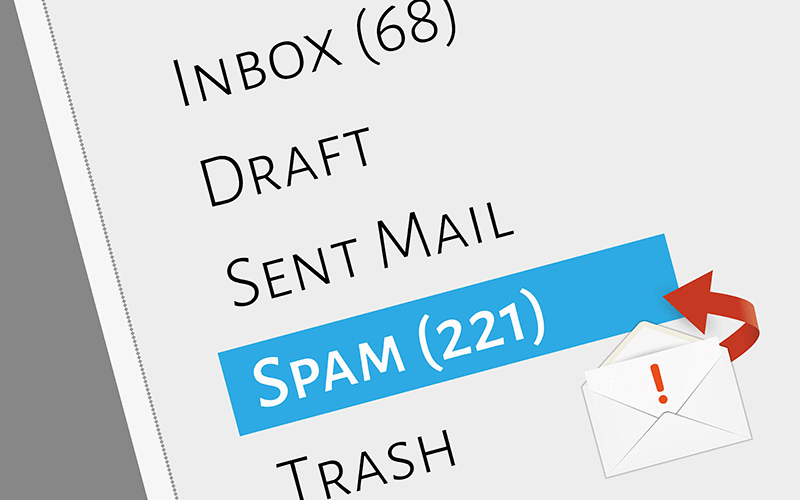When you send an email, your message can be delivered to one of four places:
- The majority of sent messages go exactly where you’d like them to go: your recipients’ inboxes.
- A growing number of messages land in junk or spam folders that may or may not be accessible to the addressee.
- Sometimes the message is returned to the sender, bouncing back to you as undeliverable.
- Occasionally, the message is missing in action, lost forever in the Internet’s version of never-never land.
Don’t let your legitimate email marketing campaigns fall victim to increasingly scrupulous spam filters. This issue of Good Thinking provides seven strategies for navigating spam filters and improving the deliverability of your messages.
The Internet brims with an endless onslaught of spam. Microsoft, for example, reports that 4.5 billion spam messages are blocked from Outlook.com inboxes every day. When designing filtering programs, IT departments and email services like Outlook, Gmail and Yahoo are being forced to err on the side of caution, and rightly so.
But what does this mean for legitimate email marketers? To spam filters, your message is guilty until proven innocent. A growing percentage of legitimate email is being directed by well-intentioned filtering systems to spam and bulk mail folders instead of inboxes. As a result, you may see good delivery statistics for your messages but your open rates may actually be dropping.
Our email marketing software (eMS) makes it easy for email servers to recognize you as a legitimate sender, but there are still some steps you should take to get more messages into subscribers’ inboxes.
1. If you haven’t already, set up an SPF record on your domain. All Katey Charles Communications clients are advised to become Sender ID compliant. This means adding what’s called an SPF record to your domain name system (DNS) records. The SPF record will let email services know that you are sending email messages from a third-party, or “outsourced,” server. Check with your Katey Charles Communications account manager for help setting up an SPF record.
2. Set up Domain Keys and DKIM. DKIM stands for Domain Keys Identified Mail. DKIM is a digital signature that’s placed in your email header. The signature acts like a key, allowing Internet and email service providers to verify your identity and prove that your email is not forged. Check with your Katey Charles Communications account manager for help setting up DKIM. Gmail, Yahoo and many corporate email servers use DKIM to help determine if they will deliver your email.
3. Maintain a consistent “from” address, and encourage each of your subscribers to add the address to his or her address book or list of accepted senders. This not only increases your inbox delivery by allowing the message to bypass filters, but it also becomes more likely that when the mail arrives, images and URLs will be enabled by default. The best way to encourage recipients to take this action is by using a standard header or footer on all your messages that asks subscribers to add your “from” address to their address books. In addition, if you are using the standard sign-up form generated in your eMS account for online signups, you will notice that a “Thank You” page pops up immediately once someone has filled out your form. That page includes a request for new subscribers to add your address to their address books.
4. Run a deliverability test periodically to spot-check for issues. Inbox Monitor Reports are available through eMS on a cost-per-use basis, once activated. You can use this tool to quickly measure the effectiveness of your email marketing efforts and spot deliverability changes and problems with particular email domains. The testing tool sends your email to a seed list that contains hundreds of addresses from the top U.S. email domains. If the report indicates a deliverability issue, we can help you investigate any problems that may be affecting the delivery of your campaigns. To activate Domain Delivery Reports for your account, contact us at (314) 918-8088 or .
5. Segment old, invalid, or inactive email addresses into an exclusion list. Chances are you have a number of subscribers who haven’t opened a message from you in ages. It’s time to treat these subscribers differently than those who routinely open your messages. Consider reaching out to inactive subscribers with a special message or campaign designed to re-engage them, or place them in a specific segment and establish a less-frequent sending strategy for this group. Before making a decision, you’ll want to start by searching for subscribers who have not opened a message from you or clicked on any hyperlink in more than 12 months. Not sure how to search for these inactive subscribers or what to do with them? Call us at (314) 918-8808 or email .
6. Check and double-check your message links before clicking send. If any URL in your message points to an invalid website, your message is at risk for delivery problems.
7. Provide relevant content to subscribers. Providing relevant content to subscribers increases your open rates and click-through rates and decreases the chances that subscribers will flag an email as spam. When determining whether a message will be delivered to the inbox, many email services consider how engaged their subscribers are with the sender’s messages and how many complaints or spam reports they’ve received from the sender.
Please let us know what you think of this issue of Good Thinking: Seven Strategies for Improving Email Deliverability. We appreciate your suggestions for future topics! Email with your ideas.

